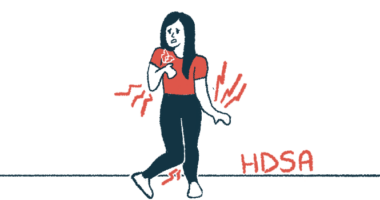Quetiapine for Huntington’s disease
Last updated July 19, 2024, by Marisa Wexler, MS

What is quetiapine for Huntington’s disease?
Quetiapine is a second-generation antipsychotic approved by the U.S. Food and Drug Administration for certain psychiatric conditions, including schizophrenia, a condition marked by a disconnection from reality, and bipolar disorder, which is characterized by extreme mood swings, including manic and depressive episodes.
It may sometimes be used off-label to help manage certain behavioral symptoms of Huntington’s disease, including psychotic problems, agitation, irritability, and insomnia. There are also reports of its off-label use to manage movement problems like chorea (uncontrolled, involuntary movements).
Quetiapine was originally developed by AstraZeneca, which markets it in the U.S. under the brand name Seroquel for its oral tablet formulation and Seroquel XR for its extended-release tablet formulation. There are also many generic forms of these formulations available in the U.S.
Therapy snapshot
| Treatment name: | Quetiapine |
| Administration: | Oral tablets |
| Clinical testing: | Used off-label in Huntington’s to treat certain psychotic and movement problems |
How does quetiapine work?
Huntington’s is a genetic disorder characterized by the progressive dysfunction and death of nerve cells in the brain. Disruptions in nerve cell signaling ultimately give rise to symptoms, including motor issues, cognitive deficits, and psychiatric problems such as irritability, agitation, anxiety, and depression.
Quetiapine is a second-generation, or atypical, antipsychotic medication, meaning that it’s less likely to result in certain side effects, such as movement abnormalities than first-generation antipsychotic treatments.
While its exact mechanisms of action aren’t fully understood, the therapy’s antipsychotic effects are thought to be mediated mainly by its ability to regulate dopamine and serotonin signaling.
Dopamine and serotonin are both neurotransmitters, that is, signaling molecules that neurons use to communicate with each other and the rest of the body, that play central roles in regulating mood and movement. Abnormal levels of these neurotransmitters have been associated with behavioral and motor problems.
Quetiapine specifically binds to and blocks certain receptor proteins of these neurotransmitters: a serotonin receptor called 5-HT2A and a dopamine receptor called D2. Its anti-anxiety and antidepressant effects are thought to also be due to the partial activation of another serotonin receptor, called 5-HT1A.
By modulating serotonin and dopamine signaling, and potentially normalizing it, in the brain, quetiapine may help ease mood and movement issues linked to abnormal levels of these neurotransmitters.
How is quetiapine administered in Huntington’s disease?
Quetiapine is an oral therapy that may be taken with or without food. There are two different forms of quetiapine tablets available:
- Regular, immediate-release oral tablets at doses of 25 mg, 50 mg, 100 mg, 200 mg, 300 mg, and 400 mg.
- Extended-related oral tablets at doses of 50 mg, 150 mg, 200 mg, 300 mg, and 400 mg.
Quetiapine is typically started at a low daily dose — 50 mg — representing one 25 mg immediate-release tablet twice a day or one 50 mg extended-release tablet once a day. The dose is then gradually increased based on the patient’s response to a recommended daily dose and ranges from 150 mg to up to 800 mg, and a maximum of up to 800 mg per day.
Lower starting doses are recommended for elderly or debilitated patients and those who are more prone to have sudden drops in blood pressure, and patients with liver problems.
Quetiapine’s dose should also be reduced in patients on medications that suppress a liver enzyme called CYP3A4, including certain antidepressants, antivirals, and antifungals. In turn, those also taking medications or medicinal plants that boost CYP3A4’s activity — including certain antiseizure treatments, antibiotics, and St. John’s wort — should increase their dose.
In the few case series and case studies reporting on quetiapine’s use in people with Huntington’s, a therapeutic benefit was reported at daily doses that ranged from 150 mg to 600 mg.
Common side effects of quetiapine
The most common side effects of quetiapine in clinical trials involving adults with schizophrenia or bipolar disorder, but not Huntington’s specifically, include:
- sleepiness
- dry mouth
- dizziness
- fatigue, weakness, and lack of energy
- postural hypotension (a sudden drop in blood pressure upon rising)
- constipation
- abdominal pain
- indigestion
- sore throat
- increased appetite and weight gain
- increased levels of liver damage markers
- speech difficulties
- nasal congestion.
The most commonly reported side effects in children and adolescents include:
- sleepiness
- dizziness
- fatigue
- increased appetite
- nausea
- vomiting
- dry mouth
- abnormally fast heart rate
- weight gain.
Mortality risk in elderly people with dementia-related psychosis
While quetiapine is not approved for treating people with psychosis associated with dementia, its prescribing information carries a boxed warning that notes that atypical antipsychotics may increase the risk of death in elderly patients with dementia-related psychosis. It also says that in such patients, atypical antipsychotics were associated with an increased risk of life-threatening cardiovascular events like stroke.
Suicidality
Quetiapine’s boxed warning also notes that the drug may increase the risk of suicidal thoughts and behaviors in adolescents and young adults. Patients on the therapy should be closely monitored by clinicians as well as friends and family for changes in mood or behaviors, especially in the first few months after starting it and at times of dose changes.
If patients experience irritability, agitation, behavior changes, persistently worse depression, or suicidal thoughts or behaviors, these symptoms should be reported immediately to healthcare providers, who should consider changing the treatment regimen, including potentially discontinuing quetiapine.
To minimize the chances of overdose, prescriptions of quetiapine should contain the minimum reasonable quantity of tablets.
Cognitive and motor problems
Quetiapine, like other atypical antipsychotics, can affect a person’s judgment and cause side effects like sleepiness, postural hypotension, and movement instability. As such, people on the therapy may have an increased risk of falls, and should therefore be regularly assessed for fall risk.
Similarly, patients taking quetiapine should avoid situations where being sleepy might be dangerous, such as driving or operating machinery, until they are certain on how the medication affects them.
Tardive dyskinesia
Antipsychotics can cause tardive dyskinesia, a disorder marked by uncontrolled movements in the face, tongue, and other body parts. The risk is higher with higher cumulative doses of the therapy, so quetiapine should be prescribed in a manner to minimize this risk.
Of note, antipsychotic medications themselves may ease symptoms of tardive dyskinesia, potentially masking the disorder in patients being treated.
If tardive dyskinesia occurs, discontinuing quetiapine should be considered. The movement disorder may ease or disappear after stopping the drug, though in some patients it may be irreversible.
Changes in blood pressure
Patients on quetiapine may experience orthostatic hypotension, which refers to a sudden drop in blood pressure when standing up from a lying or seated position, which can lead to symptoms that include dizziness, lightheadedness, and fainting.
Quetiapine should be used with caution in patients with cardiovascular disorders or other conditions that may increase the risk of low blood pressure. The risk of orthostatic hypotension may be minimized by starting the therapy at a low dose of 25 mg twice daily.
The medication also has been reported to cause an increase in blood pressure when used in children or adolescents with schizophrenia or bipolar disorder. Blood pressure should be monitored regularly in young people taking the therapy.
Metabolic changes
Quetiapine may cause changes in metabolism such as weight gain, increased fat levels, and increased blood sugar levels, including in some cases extreme increases in blood sugar leading to coma or death. Blood sugar and fat levels, as well as body weight, should be monitored regularly for all patients taking the medication.
Hormonal changes
Quetiapine may increase the risk of hypothyroidism, referring to low levels of the thyroid hormone thyroxine. The therapy also can cause an increase in levels of prolactin, which is one of the main hormones that regulates lactation.
Increased prolactin may lead to weakened bones in people of all sexes. There’s also some lab data that show high prolactin levels may increase the risk of certain cancers, especially breast cancer, though there aren’t solid data that taking quetiapine is tied to an increased risk of cancers in people.
Body temperature
Some antipsychotic medicines can disrupt the body’s ability to regulate its own temperature. This has not been reported with quetiapine specifically, but caution is advised when using the therapy for patients who are at risk of an increase in body temperature, such as those living in very warm areas.
Seizures
Quetiapine may increase the risk of seizures and it should be used with caution in patients who have a history of seizures or medical disorders that may increase seizure risk.
Swallowing problems
Antipsychotics such as quetiapine may cause swallowing difficulties (dysphagia), which are already common in people with Huntington’s. This can set the stage for aspiration, when food or liquid goes down the windpipe into the lungs, which can lead to pneumonia. Antipsychotics should be used with caution in patients at risk of aspiration pneumonia.
Withdrawal
In rare cases, abruptly stopping quetiapine may lead to withdrawal symptoms such as nausea, vomiting, and insomnia. To minimize this risk, the medication should be gradually withdrawn where possible.
Anticholinergic (antimuscarinic) effects
Quetiapine’s active byproduct, norquetiapine, can suppress the activity of certain muscarinic receptors, cell-surface proteins that are activated by acetylcholine, another neurotransmitter. This can lead to adverse reactions associated with anticholinergic, or antimuscarinic, effects, such as constipation. As such, caution is advised when prescribing the therapy to patients on other medications with anticholinergic effects and those with a history of constipation.
Use in pregnancy and breastfeeding
A registry study is collecting data from people exposed to atypical antipsychotics, including quetiapine, during pregnancy. It can be reached online or by phone at 1-866-961-2388.
To date, available data suggest that using quetiapine during pregnancy does not increase the risk of major birth defects, miscarriage, or other major health problems for the fetus or the pregnant person.
However, there have been reports of extrapyramidal and/or withdrawal symptoms — such as abnormal muscle tone, tremor, agitation, sleepiness, difficulty feeding, or difficulty breathing — in newborns exposed to the therapy in the later stages of pregnancy. Some babies recovered in hours or days without specific treatment, but others required more intensive care. As such, babies born after such exposure should be monitored for these reactions, with appropriate supportive care given as needed.
While quetiapine has been detected in human breast milk, no consistent adverse events have been reported in infants exposed to the therapy through breast milk. Also, whether the therapy affects milk production is unclear.
Patients who are pregnant or breastfeeding or who plan to become pregnant or breastfeed should discuss this with their healthcare providers, carefully weighing the potential risks and benefits of treatment in these situations.
Huntington’s Disease News is strictly a news and information website about the disease. It does not provide medical advice, diagnosis or treatment. This content is not intended to be a substitute for professional medical advice, diagnosis, or treatment. Always seek the advice of your physician or other qualified health provider with any questions you may have regarding a medical condition. Never disregard professional medical advice or delay in seeking it because of something you have read on this website.
Recent Posts
- What I want people to stop saying about Huntington’s disease
- HDSA 2025: Dance classes may improve balance in Huntington’s
- HDSA 2025: Long-term care transition requires communication
- Guest Voice: Huntington’s disease is rare, but love isn’t
- HDSA 2025: Observational studies in Huntington’s now enrolling in US
- HDSA 2025: Speakers spotlight Huntington’s clinical trials
- HDSA 2025: Speech therapy can help Huntington’s disease patients
- HDSA 2025: Early planning key for navigating care over time
- HDSA 2025: Psychedelic compound eases depression in mice
- HDSA 2025: Support can help combat Huntington’s disease stigma






